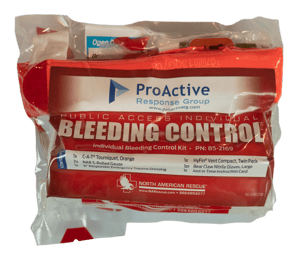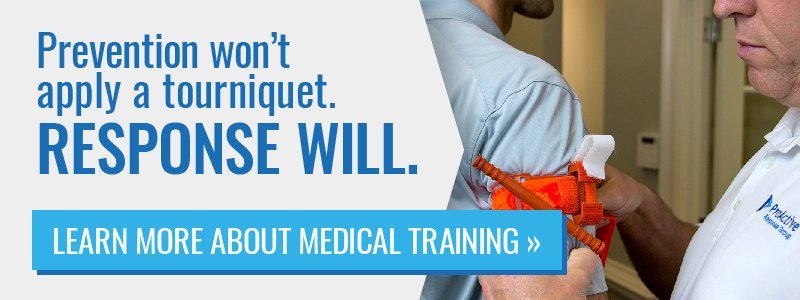 First aid kits have their place — like maybe when you get a paper cut or tear a hangnail — but the bandaids and antiseptic wipes in your basic first aid kit will not stop severe bleeding or help you treat any other kind of life-threatening injury.
First aid kits have their place — like maybe when you get a paper cut or tear a hangnail — but the bandaids and antiseptic wipes in your basic first aid kit will not stop severe bleeding or help you treat any other kind of life-threatening injury.
It's time to increase your preparedness. Instead of preparing for basic first aid, train for emergency medical response, especially bleed control. After all, if you're ready to effectively handle the big things, then responding to the little things like minor incisions are second nature. Everybody wins when you're prepared to respond to severe hemorrhage but only have to clean up a scraped knee on the playground.
Better to have it and not need it, than to need it and not have it, they say. That couldn't be more true in the context of medical kits. Let's look at 5 specific items you should always have in your emergency medical kit.
Tourniquet
Tourniquets are not just for police or military personnel. We know everyday people who have stumbled upon car accidents and saved the life of someone who was seriously injured because they had a tourniquet with them.
While a tourniquet's design has changed since its invention in the late 1800s, tourniquets remain an effective tool for stopping severe bleeding from an appendage. If your emergency medical kit doesn't have a tourniquet, then it's not emergency-ready.
Wound-packing Gauze
Another piece of medical equipment used to stop severe bleeding is wound-packing gauze. Gauze is necessary to stop bleeding in areas of the body where a tourniquet would be ineffective. For example, a shoulder wound should be packed with gauze because these injury sites are not on an extremity.
While there are various types of wound-packing gauze available, S-rolled gauze is one of the most popular for its ease of use in an emergency.
Chest Seal
True to their name, chest seals are used to seal wounds in the chest — usually from a knife or gunshot. Injuries to the chest present a unique concern because not only do they cause bleeding, but they expose the chest cavity to outside air. which hinders breathing and can cause a lung to collapse.
A chest seal is designed to be used on injuries between the collar bone and belly button. When applying a chest seal, you will need to clear the wound of blood to ensure that it seals properly. Be sure to also check for exit wounds and apply a chest seal to those as well.
Pressure Dressing
Pressure dressings can be used to stop bleeding when a.) you do not want to cut off blood flow by using a tourniquet or b.) the injury site is on the head or trunk where a tourniquet cannot be applied. The advantage of using a pressure dressing over basic gauze and applying manual pressure is that with a pressure dressing, you can apply it and leave it. Depending on the situation, you may not be able to stay by the side of a wounded individual and keep pressure on the wound.
Gloves
While all of the other items in your emergency medical kit are for the safety of those you are treating, gloves are for the safety of the injured as well as your own. By wearing sterile gloves, you reduce the risk of contaminating an injury, and you also protect yourself from exposure to blood-born or transmissible diseases. Certainly, not having gloves should not keep you from treating an injured person, but having them is preferable.
To learn more about the medical equipment mentioned in this article and get hands-on practice, contact us today and sign up for one of our Medical Response Training classes!
.png?width=499&height=133&name=Logo-menu%20(1).png)



